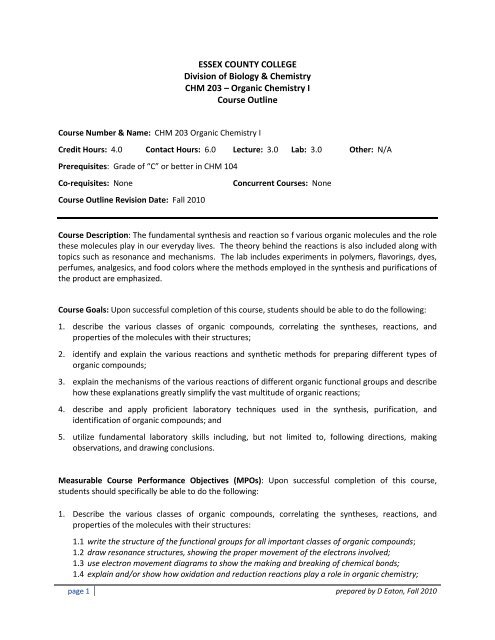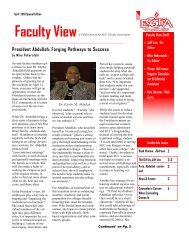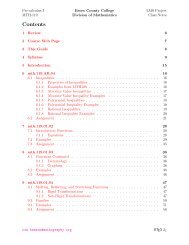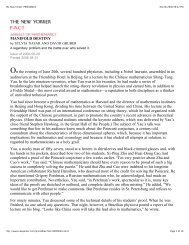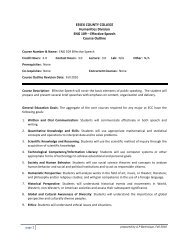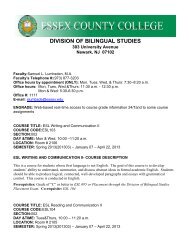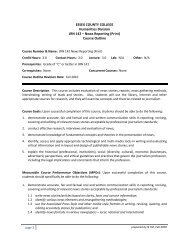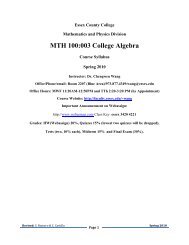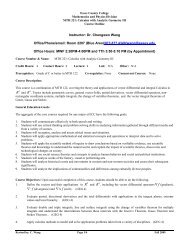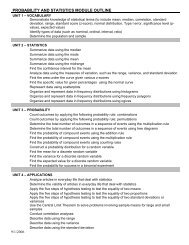ESSEX COUNTY COLLEGE Division of Biology & Chemistry CHM 203
ESSEX COUNTY COLLEGE Division of Biology & Chemistry CHM 203
ESSEX COUNTY COLLEGE Division of Biology & Chemistry CHM 203
Create successful ePaper yourself
Turn your PDF publications into a flip-book with our unique Google optimized e-Paper software.
<strong>ESSEX</strong> <strong>COUNTY</strong> <strong>COLLEGE</strong><br />
<strong>Division</strong> <strong>of</strong> <strong>Biology</strong> & <strong>Chemistry</strong><br />
<strong>CHM</strong> <strong>203</strong> – Organic <strong>Chemistry</strong> I<br />
Course Outline<br />
Course Number & Name: <strong>CHM</strong> <strong>203</strong> Organic <strong>Chemistry</strong> I<br />
Credit Hours: 4.0 Contact Hours: 6.0 Lecture: 3.0 Lab: 3.0 Other: N/A<br />
Prerequisites: Grade <strong>of</strong> “C” or better in <strong>CHM</strong> 104<br />
Co-requisites: None<br />
Course Outline Revision Date: Fall 2010<br />
Concurrent Courses: None<br />
Course Description: The fundamental synthesis and reaction so f various organic molecules and the role<br />
these molecules play in our everyday lives. The theory behind the reactions is also included along with<br />
topics such as resonance and mechanisms. The lab includes experiments in polymers, flavorings, dyes,<br />
perfumes, analgesics, and food colors where the methods employed in the synthesis and purifications <strong>of</strong><br />
the product are emphasized.<br />
Course Goals: Upon successful completion <strong>of</strong> this course, students should be able to do the following:<br />
1. describe the various classes <strong>of</strong> organic compounds, correlating the syntheses, reactions, and<br />
properties <strong>of</strong> the molecules with their structures;<br />
2. identify and explain the various reactions and synthetic methods for preparing different types <strong>of</strong><br />
organic compounds;<br />
3. explain the mechanisms <strong>of</strong> the various reactions <strong>of</strong> different organic functional groups and describe<br />
how these explanations greatly simplify the vast multitude <strong>of</strong> organic reactions;<br />
4. describe and apply pr<strong>of</strong>icient laboratory techniques used in the synthesis, purification, and<br />
identification <strong>of</strong> organic compounds; and<br />
5. utilize fundamental laboratory skills including, but not limited to, following directions, making<br />
observations, and drawing conclusions.<br />
Measurable Course Performance Objectives (MPOs): Upon successful completion <strong>of</strong> this course,<br />
students should specifically be able to do the following:<br />
1. Describe the various classes <strong>of</strong> organic compounds, correlating the syntheses, reactions, and<br />
properties <strong>of</strong> the molecules with their structures:<br />
1.1 write the structure <strong>of</strong> the functional groups for all important classes <strong>of</strong> organic compounds;<br />
1.2 draw resonance structures, showing the proper movement <strong>of</strong> the electrons involved;<br />
1.3 use electron movement diagrams to show the making and breaking <strong>of</strong> chemical bonds;<br />
1.4 explain and/or show how oxidation and reduction reactions play a role in organic chemistry;<br />
page 1 prepared by D Eaton, Fall 2010
Measurable Course Performance Objectives (MPOs) (continued):<br />
1.5 explain and/or show how various chemical catalysts and enzymes can alter organic reactions;<br />
1.6 explain what nucleophiles and electrophiles are and show how they affect various organic<br />
reactions;<br />
1.7 explain and/or show how chemical kinetics, the equilibrium constant, free energy changes,<br />
enthalpy, and entropy can alter various organic reactions; and<br />
1.8 name a variety <strong>of</strong> organic compounds<br />
2. Identify and explain the various reactions and synthetic methods for preparing different types <strong>of</strong><br />
organic compounds:<br />
2.1 synthesize organic compounds from given starting materials utilizing a series <strong>of</strong> organic<br />
reactions; and<br />
2.2 use retro-synthetic analysis to determine the starting materials for organic syntheses<br />
3. Explain the mechanisms <strong>of</strong> the various reactions <strong>of</strong> different organic functional groups and describe<br />
how these explanations greatly simplify the vast multitude <strong>of</strong> organic reactions:<br />
3.1 explain and show the proper mechanisms for organic reactions; and<br />
3.2 explain and show how the structure <strong>of</strong> an organic compound will alter the mechanism <strong>of</strong> how it<br />
reacts<br />
4. Describe and apply pr<strong>of</strong>icient laboratory techniques used in the synthesis, purification, and<br />
identification <strong>of</strong> organic compounds:<br />
4.1 describe distillation, filtration, extraction, drying, chromatography, and recrystallization; and<br />
4.2 use distillation, filtration, extraction, drying, chromatography, and/or recrystallization to<br />
synthesize, purify, and identify organic compounds<br />
5. Utilize fundamental laboratory skills including, but not limited to, following directions, making<br />
observations, and drawing conclusions:<br />
5.1 show in the laboratory pr<strong>of</strong>iciency in fundamental lab skills such as following directions, making<br />
observations and drawing conclusions;<br />
5.2 correctly use/handle laboratory equipment;<br />
5.3 isolate the proper amount <strong>of</strong> the purified product; and<br />
5.4 apply lecture concepts in the laboratory<br />
Methods <strong>of</strong> Instruction: Instruction will consist <strong>of</strong> a combination <strong>of</strong> lectures, laboratory experiments,<br />
and various learning exercise and problem assignments.<br />
Outcomes Assessment: Homework and test questions are blueprinted to course objectives. Lab<br />
experiments are scored with checklist rubrics for the presence <strong>of</strong> course objectives. Data is collected<br />
and analyzed to determine the level <strong>of</strong> student performance on these assessment instruments in<br />
regards to meeting course objectives. The results <strong>of</strong> this data analysis are used to guide necessary<br />
pedagogical and/or curricular revisions.<br />
page 2 prepared by D Eaton, Fall 2010
Course Requirements: All students are expected to:<br />
1. Attend class and be on time. Absences or late arrivals negatively affect student understanding <strong>of</strong><br />
the material and, therefore, performance in the course.<br />
2. Complete assigned reading, homework, and laboratory assignments as scheduled.<br />
3. Take tests when scheduled. Policies regarding make-up tests are established by individual<br />
instructors.<br />
Methods <strong>of</strong> Evaluation: Final course grades will be computed as follows:<br />
Grading Components<br />
% <strong>of</strong><br />
final course grade<br />
• Attendance/Punctuality 5%<br />
Attendance is essential as students cannot otherwise<br />
participate in class discussions or laboratory activities,<br />
which are designed to enhance understanding <strong>of</strong> the<br />
course objectives.<br />
• Homework 15%<br />
Homework is assigned to reinforce the course objectives<br />
and give students the practice and know-how to do<br />
similar problems on the exams. A perusal <strong>of</strong> homework<br />
problems will provide evidence <strong>of</strong> the achievement <strong>of</strong><br />
course objectives.<br />
• Laboratory Experiments 20%<br />
Laboratory experiments measure the students’ abilities in<br />
the lab and reinforce the relevance <strong>of</strong> the laboratory<br />
topics to the textbook. Lab performance is evaluated for<br />
the presence <strong>of</strong> various course objectives.<br />
• 4 or more Tests (dates specified by the instructor) 60%<br />
Tests, which include content from the textbook, the<br />
lectures, and the laboratory experiments, will show<br />
evidence <strong>of</strong> the extent to which students meet course<br />
objectives.<br />
page 3 prepared by D Eaton, Fall 2010
Academic Integrity: Dishonesty disrupts the search for truth that is inherent in the learning process and<br />
so devalues the purpose and the mission <strong>of</strong> the College. Academic dishonesty includes, but is not<br />
limited to, the following:<br />
• plagiarism – the failure to acknowledge another writer’s words or ideas or to give proper credit<br />
to sources <strong>of</strong> information;<br />
• cheating – knowingly obtaining or giving unauthorized information on any test/exam or any<br />
other academic assignment;<br />
• interference – any interruption <strong>of</strong> the academic process that prevents others from the proper<br />
engagement in learning or teaching; and<br />
• fraud – any act or instance <strong>of</strong> willful deceit or trickery.<br />
Violations <strong>of</strong> academic integrity will be dealt with by imposing appropriate sanctions. Sanctions for acts<br />
<strong>of</strong> academic dishonesty could include the resubmission <strong>of</strong> an assignment, failure <strong>of</strong> the test/exam,<br />
failure in the course, probation, suspension from the College, and even expulsion from the College.<br />
Student Code <strong>of</strong> Conduct: All students are expected to conduct themselves as responsible and<br />
considerate adults who respect the rights <strong>of</strong> others. Disruptive behavior will not be tolerated. All<br />
students are also expected to attend and be on time all class meetings. No cell phones or similar<br />
electronic devices are permitted in class. Please refer to the Essex County College student handbook,<br />
Lifeline, for more specific information about the College’s Code <strong>of</strong> Conduct and attendance<br />
requirements.<br />
page 4 prepared by D Eaton, Fall 2010
Course Content Outline: based on the text Organic <strong>Chemistry</strong>, 3 rd<br />
McGraw-Hill<br />
edition, by Smith; published by<br />
NOTE: A hand-held scientific calculator is also required for this course.<br />
Week<br />
Chapter/Topic<br />
1 Chapter 1 Structure and Bonding<br />
2 Chapter 1 Structure and Bonding (continued)<br />
Chapter 2 Acids and Bases<br />
3 Chapter 2 Acids and Bases (continued)<br />
Chapter 3 Introduction to Organic Molecules and Functional Groups<br />
4 Chapter 3 Introduction to Organic Molecules and Functional Groups (continued)<br />
Lab 1: Measuring the Melting Points <strong>of</strong> Compounds and Mixtures<br />
Test 1 on Chapters 1 – 3 and lab<br />
5 Chapter 4 Alkanes<br />
6 Chapter 4 Alkanes (continued)<br />
Chapter 5 Stereochemistry<br />
7 Chapter 5 Stereochemistry (continued)<br />
Chapter 6 Understanding Organic Reactions<br />
8 Chapter 6 Understanding Organic Reactions (continued)<br />
Lab 2: Naming Organic Compounds<br />
Test 2 on Chapters 4 – 6 and lab<br />
9 Chapter 7 Alkyl halides and Nucleophilic Substitution Reactions<br />
10 Chapter 8 Alkyl halides and Elimination Reactions<br />
11 Chapter 9 Alcohols, Ethers, and Epoxides<br />
12 Lab 3: Purifying Acetanilide by Recrystallization<br />
Test 3 on Chapters 7 – 9 and lab<br />
Chapter 10 Alkenes<br />
13 Chapter 10 Alkenes (continued)<br />
Chapter 11 Alkynes<br />
14 Chapter 11 Alkynes (continued)<br />
Chapter 12 Oxidation and Reduction<br />
page 5 prepared by D Eaton, Fall 2010
Week<br />
Chapter/Topic<br />
15 Chapter 12 Oxidation and Reduction (continued)<br />
Lab 4: Separating Acids and Neutral Compounds by Solvent Extraction<br />
Test 4 on Chapters 10 – 12 and lab<br />
page 6 prepared by D Eaton, Fall 2010


